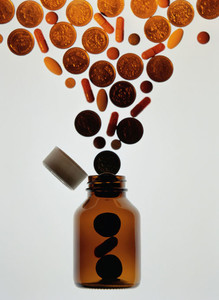Rapidly increasing pharmaceutical expenditures have become a constant challenge to the sustainability of healthcare systems across countries including Korea.
Policies for pharmaceuticals can be divided into either supply- or demand-side measures. Price reductions for drugs are one of the principal supply-side measures universally implemented by authorities to help control drug expenditures. This was seen among European countries where price cuts, changes in co-payments and medicine VAT rates were among the most frequent measures implemented by them in response to the recent financial crisis. However, expenditures have continued to rise in a number of countries despite such measures. This may reflect a lack of demand-side measures enhancing the rational use of medicines including effective low cost generics versus more expensive patented products [1].
The South Korean Government has implemented a number of policies in recent years to regulate pharmaceutical expenditures. However, most regulations have focused on price controls. These include price reductions such as price-volume agreements as well as price cuts including after generics entry. There has, however, been limited focus in South Korea on measures to influence prescribing, including measures to enhance the rational use of medicines.
To date, there have been limited evaluations of the effects of price control policies on future drug spending in countries including South Korea. Since 2007, anti-hyperlipidaemic drugs have been a target for price regulations. Price control mechanisms have included price cuts after patent expiration and price cuts according to the drug list rearrangement project (DRP).
Consequently, the aim of this study [2] was to assess the impact of successive price reduction measures on the overall expenditure of drugs to treat hypercholesterolemia in South Korea. This was undertaken retrospectively through examining the effects of price-reduction policies on drug expenditures for anti-hyperlipidaemic drugs between 2006 and 2010 using the National Health Insurance claims datasets and a segmented regression analysis design.
The results showed that despite three rounds of price cuts, monthly drug expenditures on anti-hyperlipidaemic drugs still rose appreciably, increasing by KRW 599.6658 million (US$523,726) (p = 0.0781). Volumes also increased, but not significantly. The unit prices showed a steady downward trend over time, but rebounded after the third price cut. The number of patients with hyperlipidaemia more than doubled during the study period.
Overall, extensive price controls did not effectively suppress growth in pharmaceutical expenditures in Korea in this drug class. The increased number of patients, aided by the launch of generic atorvastatin, coupled with the increasing use of premium priced patented drugs, were major factors leading to increased drug spending.
Consequently, policies that regulate both prices, as well as enhance the utilization of low cost generics where all products are seen as essential similar such as proton pump inhibitors (PPIs), statins and renin angiotensin inhibiting drugs, would appear to be the optimal solution to control future expenditures without compromising care. This was seen in Scotland where reimbursed expenditure for the PPIs in 2010 was 56% below 2001 levels despite a 3-fold increase in utilization. It was estimated that PPI expenditure would have been GBP 159 million greater for a 5.2 million population without such measures. Similarly, reimbursed expenditure for statins in 2010 was only 7% above 2001 levels despite a 6.2-fold increase in utilization. Again, it was estimated that statin expenditure would have been GBP 290 million greater in 2010 without such measures.
Similarly in The Netherlands, reimbursed expenditure for PPIs fell by 58% in 2010 versus 2000 despite a 3-fold increase in utilization, helped by increasing utilization of generic omeprazole at only 2% of pre-patent loss prices. Similarly, reimbursed expenditure for statins fell by 14% in 2010 versus 2000 despite a 3.8-fold increase in utilization. This was again helped by increasing utilization of generic simvastatin at only 2% of the pre-patent loss originator price.
Conflict of interest
The authors of the research paper [1] declared that there were no conflicts of interest.
Abstracted by Dr Brian Godman, member of International Editorial Advisory Board, GaBI Journal.
Related articles
Impact of delisting ARBs in Denmark
Generic atypical antipsychotic drugs in Belgium
References
1. Simoens S. A review of generic medicine pricing in Europe. Generics and Biosimilars Initiative Journal (GaBI Journal). 2012;1(1):8-12. doi:10.5639/gabij.2012.0101.004
2. Kwon HY, Hong JM, Godman B, Yang BM. Price cuts and drug spending in South Korea: the case of antihyperlipidemic agents. Health Policy. 2013;112(3):217-26.
Permission granted to reproduce for personal and non-commercial use only. All other reproduction, copy or reprinting of all or part of any ‘Content’ found on this website is strictly prohibited without the prior consent of the publisher. Contact the publisher to obtain permission before redistributing.
Copyright – Unless otherwise stated all contents of this website are © 2014 Pro Pharma Communications International. All Rights Reserved.








 0
0











Post your comment